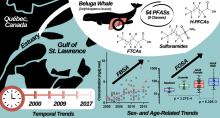| Title | Underlying mechanisms of reproductive toxicity caused by multigenerational exposure of 2, bromo-4, 6-dinitroaniline (BDNA) to Zebrafish (Danio rerio) at environmental relevant levels. |
| Publication Type | Journal Article |
| Year of Publication | 2019 |
| Authors | Xie, X, Jin, Y, Ma, Z, Tang, S, Peng, H, Giesy, JP, Liu, H |
| Journal | Aquat Toxicol |
| Volume | 216 |
| Pagination | 105285 |
| Date Published | 2019 Nov |
| ISSN | 1879-1514 |
| Keywords | Aniline Compounds, Animals, DNA Damage, Environmental Exposure, Female, Larva, Male, Principal Component Analysis, Reproduction, Toxicity Tests, Transcription, Genetic, Transcriptome, Vitellogenins, Water Pollutants, Chemical, Zebrafish |
| Abstract | 2-bromo-4, 6-dinitroaniline (BDNA) is a mutagenic aromatic amine involved in the production and degradation of Disperse blue 79, one of the most extensively used brominated azo dyes. In our previous study, a multigenerational exposure of BDNA (0.5, 5, 50 and 500 μg/L) to zebrafish from F adult to F larvae including a recovery group in F larvae was conducted. The effects on apical points observed in individuals and the long-term effects predicted on population were all related to reproduction. In this study, we performed molecular analysis to elucidate the underlying mechanisms of the reproductive toxicity of BDNA. In F generation, measurement of vitellogenin and transcription levels of genes associated with hypothalamus-pituitary-gland (HPG) axis, estrogen receptor (ER) and androgen receptor (AR) were conducted. There was a decrease in VTG level in the blood of F female fish and transcription of genes related to ER was more affected than that of genes related to AR. These results were consistent with adverse effects that sexual differentiation was biased towards males and fecundity was impaired in a concentration-dependent manner in adults of F generation after 150 days exposure. In F generation, global gene transcriptions of F larvae were investigated. It was uncovered that processes related to apoptosis, development and DNA damage were strongly affected. Alterations to these biological pathways accounted for the irreversible parental influence on a significant decrease in hatchability and increase in abnormality of F larvae. All evidence suggested that the multigenerational exposure of BDNA posed lasting effects transmitted from parents to offspring that persisted after exposure ceased. |
| DOI | 10.1016/j.aquatox.2019.105285 |
| PubMed ID | 31546070 |
Environmental Chemical Biology

